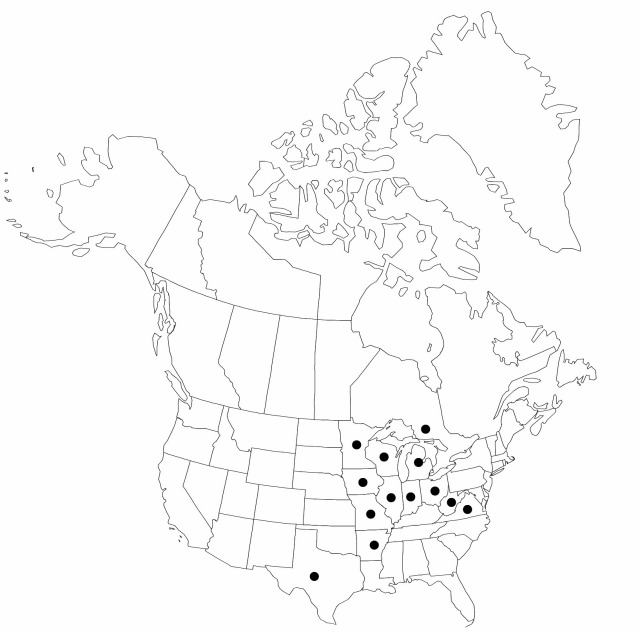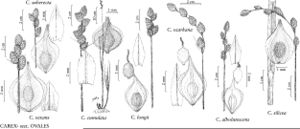Difference between revisions of "Carex suberecta"
Man. Fl. N. States ed. 2, 1057. 1905.
FNA>Volume Importer |
imported>Volume Importer |
||
| (5 intermediate revisions by 2 users not shown) | |||
| Line 7: | Line 7: | ||
|year=1905 | |year=1905 | ||
}} | }} | ||
| − | |basionyms={{Treatment/ID/ | + | |special_status={{Treatment/ID/Special_status |
| + | |code=F | ||
| + | |label=Illustrated | ||
| + | }}{{Treatment/ID/Special_status | ||
| + | |code=E | ||
| + | |label=Endemic | ||
| + | }} | ||
| + | |basionyms={{Treatment/ID/Basionym | ||
|name=Carex tenera var. suberecta | |name=Carex tenera var. suberecta | ||
|authority=Olney | |authority=Olney | ||
| + | |rank=variety | ||
| + | |publication_title=Caric. Bor.-Amer., | ||
| + | |publication_place=3. 1871 | ||
}} | }} | ||
|synonyms= | |synonyms= | ||
| Line 34: | Line 44: | ||
-->{{#Taxon: | -->{{#Taxon: | ||
name=Carex suberecta | name=Carex suberecta | ||
| − | |||
|authority=(Olney) Britton | |authority=(Olney) Britton | ||
|rank=species | |rank=species | ||
| Line 48: | Line 57: | ||
|publication title=Man. Fl. N. States ed. | |publication title=Man. Fl. N. States ed. | ||
|publication year=1905 | |publication year=1905 | ||
| − | |special status= | + | |special status=Illustrated;Endemic |
| − | |source xml=https:// | + | |source xml=https://bitbucket.org/aafc-mbb/fna-data-curation/src/2e0870ddd59836b60bcf96646a41e87ea5a5943a/coarse_grained_fna_xml/V23/V23_646.xml |
|genus=Carex | |genus=Carex | ||
|section=Carex sect. Ovales | |section=Carex sect. Ovales | ||
Latest revision as of 20:42, 5 November 2020
Plants cespitose; rhizomes appearing elongate in old clumps. Culms uniformly slender, 40–80 cm; vegetative culms few, inconspicuous, usually fewer than 15 leaves, not strikingly 3-ranked. Leaves: sheaths adaxially conspicuously green-veined nearly to collar, narrow hyaline band or sharp Y-shaped region at collar, adaxially firm, summits U-shaped; distal ligules 1.6–3.3 mm; blades 2–5 per fertile culm, 12–18 cm × 1.5–2.5 mm. Inflorescences stiffly erect, dense to slightly open, brown, 1.5–3(–3.5) cm × 6–14 mm; proximal internode 2–12 mm; 2d internode 2–7 mm; proximal bracts scalelike, often with bristletips shorter than or equaling inflorescences. Spikes 2–5, distant, distinct, ovoid, 7–12 × 4–7 mm, base rounded or short-acute, apex acute. Pistillate scales reddish brown, 1-veined midstripe sometimes pale, broadly lanceolate, 2.7–3.6 mm, shorter and narrower than perigynia, apex firm, acute to acuminate. Perigynia 15–80 in larger spikes, appressed, usually golden brown, conspicuously 6–9-veined abaxially, inconspicuously veined adaxially, diamond shaped, flat except over achene, 4–5 × 2–2.8 mm, 0.4–0.5 mm thick, base subacute or acute, margin flat, including wing 0.6–0.9 mm wide, smooth; beak apprressed, golden brown at tip, flat, 0.7–1.6(–1.8) mm, 2/5+ length of body, ciliate-serrulate, abaxial suture with hyaline, golden brown margin, distance from beak tip to achene 2–3 mm. Achenes elliptic to ovate, 1.5–1.7 × 0.8–1.1 mm, 0.3–0.4 mm thick. 2n = 72.
Phenology: Fruiting early summer.
Habitat: Calcareous fens and seeps, shores, swales
Elevation: 100–600 m
Distribution

Ont., Ark., Ill., Ind., Iowa, Mich., Minn., Mo., Ohio, Tex., Va., Wis., W.Va.
Discussion
Selected References
None.
